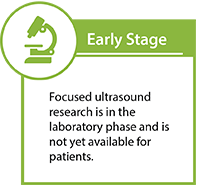Focused Ultrasound Therapy
Focused ultrasound is a noninvasive, therapeutic technology that could transform the quality of life and decrease the cost of care for patients with cerebral palsy. This novel technology focuses beams of ultrasound energy precisely and accurately on targets deep in the brain without damaging surrounding normal tissue.
How it Works
Where the beams converge, focused ultrasound energy on target tissue, and results in thermal ablation (burning) of the target, with improvement of the symptoms.
The primary options for treatment of cerebral palsy include medication and physical therapy. Unfortunately, these can be ineffective in many cases.
For certain patients, focused ultrasound could provide a non-invasive, yet more effective alternative to conventional therapy.
Advantages
- Focused ultrasound is noninvasive, so it does not carry added concerns like surgical wound healing or infection.
- Focused ultrasound can reach the desired target without damaging surrounding tissue.
- It can be repeated, if necessary.
Clinical Trials
At the present time, there are no clinical trials recruiting patients for focused ultrasound treatment of cerebral palsy.
Regulatory Approval and Reimbursement
Focused ultrasound treatment for cerebral palsy is not yet approved by regulatory bodies or covered by medical insurance companies.
Notable Papers
Jung NY, Park CK, Kim M, Lee PH, Sohn YH, Chang JW. The efficacy and limits of magnetic resonance-guided focused ultrasound pallidotomy for Parkinson’s disease: a Phase I clinical trial. J Neurosurg. 2018 Aug 1:1-9. doi: 10.3171/2018.2.JNS172514. Online ahead of print. PMID: 30095337
Jeelani NU, Jindahra P, Tamber MS, Poon TL, Kabasele P, James-Galton M, et al. ‘Hemispherical asymmetry in the meyer’s loop’: A prospective study of visual-field deficits in 105 cases undergoing anterior temporal lobe resection for epilepsy. J Neurol Neurosurg Psychiatry 81:985-991, 2010
Hamani C, Dubiela FP, Soares JC, Shin D, Bittencourt S, Covolan L, et al: Anterior thalamus deep brain stimulation at high current impairs memory in rats. Exp Neurol 225:154-162, 2010
Click here for additional references from PubMed.

